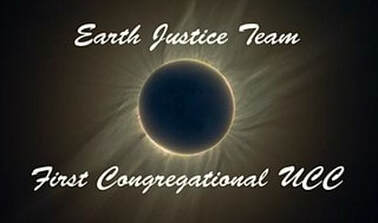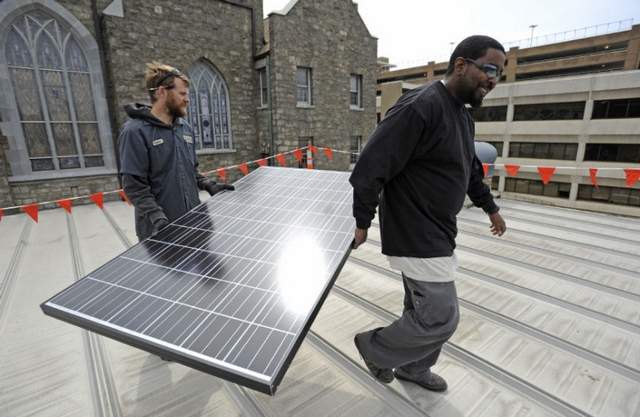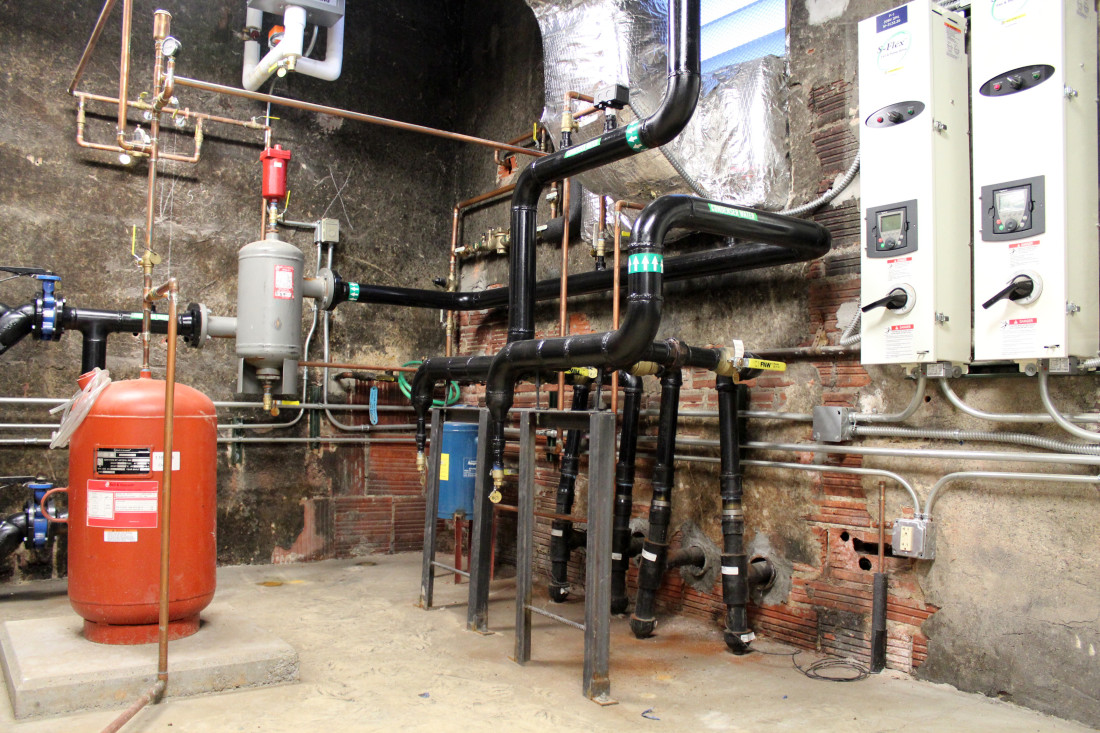Upcoming Summer Classes
July 7th, Ron Martin-Adkins will present a class on the Native American Medicine Wheel. All classes begin at 9:00am. (This event was previously planned for June, and is now moved to July 7th).
Earth Justice Team's Mission Statement
- Uphold the connection between spiritual practice and ecological consciousness. Affirm and celebrate Earth as sacred, and acknowledge our human relationship to the wondrous whole.
- Understanding how our environmental practices affect people around the earth.
- Educate ourselves and our congregation about environmental challenges.
- Consider our impact on the environment when we plan and pursue any activity in our life together as a congregation, as well as in our personal lives.
- Transform our habits and practices to contribute to a more just and sustainable future for all life on Earth.
- Provide an example of Earth-friendly practices for our community.
What we do
Earth Team is an inclusive group of FCUCC members and friends who encourage recycling, reducing our carbon footprint and promoting Earth-friendly practices on our campus and in member’s lives, and maintaining a small pollinator garden. We advocate on behalf of sound environmental policies, helping to create a clean environment and protect the Earth for future generations.
Below are a few of Earth Team’s accomplishments:
Some of the organizations that we interact with:
MountainTrue, a community collaboration for a cleaner environment.
Green Opportunities, which sponsors green job training and neighborhood improvement.
Creation Care Alliance, an inter-faith group addressing education and action on caring for the environment.
Additional Resources: United Church of Christ - A Kairos Call to Action
https://www.ucc.org/what-we-do/justice-local-church-ministries/justice/faithful-action-ministries/environmental-justice/a-kairos-call-to-action/
Below are a few of Earth Team’s accomplishments:
- Replaced energy-consuming incandescent light bulbs on the FCUCC campus with energy-efficient LED bulbs.
- Established recycling collection containers in the Friendship Hall, on the lower floor of the Education Building, in the offices and in the Narthex. Clean paper, cardboard, glass, metal, and plastic items are collected by Curbside Management and re-purposed into useful materials.
- We have a small pollinator garden behind the church which is part of the Million Pollinator Garden Challenge.
- We also coordinate with the FCUCC hospitality team so coffee time after Sunday worship uses sustainable rather than disposable cups and utensils.
- Earth Justice Team members provide leadership for occasional Sunday school and retreat classes that explore how to and why we need to take better care of the Earth.
- We contact our legislators both on the state and federal level to advocate for wise environmental solutions.
Some of the organizations that we interact with:
MountainTrue, a community collaboration for a cleaner environment.
Green Opportunities, which sponsors green job training and neighborhood improvement.
Creation Care Alliance, an inter-faith group addressing education and action on caring for the environment.
Additional Resources: United Church of Christ - A Kairos Call to Action
https://www.ucc.org/what-we-do/justice-local-church-ministries/justice/faithful-action-ministries/environmental-justice/a-kairos-call-to-action/
If you have questions or are interested in participating contact Deb Morris at [email protected] or Doug Williams at [email protected].

Our next scheduled Faith Exploration series will be during the month of September, when the Earth Justice Team reviews & discusses the book "Cathedral on Fire" by Brooks Berndt. The book is a church handbook for the climate crisis.
Books are available for purchase ($5/copy) in the narthex (front entrance of the church) on the Welcome Table. You can put your money in the acrylic locked box and take a copy home to read/study so that you are prepared for the class which will start on September 8th and run for 4 Sundays through the month of September.
Contact the Earth Justice Team with any questions.
Books are available for purchase ($5/copy) in the narthex (front entrance of the church) on the Welcome Table. You can put your money in the acrylic locked box and take a copy home to read/study so that you are prepared for the class which will start on September 8th and run for 4 Sundays through the month of September.
Contact the Earth Justice Team with any questions.
In 2011, First Congregational UCC was the first church in Asheville to install solar panels. It was achieved through the hard work and ingenuity of our very own members, with some advice and guidance from AIRE NC and NC Interfaith Power and Light. Below is a picture of Sundance Solar employees installing the panels in spring 2011.
We worked with Interfaith Power and Light to get our solar panels, an organization that is working with 14,000 church congregations in response to climate change.
Taken from Down on the (Solar) Farm by Boone Guyton on 03/05/2012, WNC Green Building Directory
Asheville’s first community solar project is on the roof of the First Congregational United Church of Christ. The Earth Team at the downtown church initiated it with help from Richard Fireman, the outreach coordinator for North Carolina Interfaith Power & Light (a program of the N.C. Council of Churches). Fireman also works with the Appalachian Institute for Renewable Energy in Western North Carolina. Sundance Power Systems installed the 42-panel, 10-kilowatt system, which was financed for the most part by church members, who formed a limited liability company called First Church Solar. Stan Corwin and Ron Martin-Adkins manage First Church Solar, which Corwin points out is appropriately named, as it’s the first community solar system on a church in the state.
The investors in the company own the system and bene8t from the tax credits, depreciation and revenue from selling the electricity and renewable energy credits. The expectation is that after about six years, the investors will have made their money back and then so
me, depending on each individual’s tax situation. At that point, they will donate the system to the church.
Corwin says that the process went smoothly and that the congregants appreciate knowing their solar system produces clean energy and reduces the amount of coal-8red power being used. Fireman reports that there were more interested people than could be accommodated by the installed system, since available space was limited on the church roof.
In 2015, we installed a geo-thermal heating and cooling unit for our Sanctuary Building.
In an article in the Mountain Xpress from December 24, 2015, Virginia Daffron wrote:
As Asheville’s First Congregational United Church of Christ approached the century mark, some of the systems that power the gray granite building on Oak Street were showing their age. In 2012, the church’s massive gas-fired boiler gave up the ghost, and the congregation had to consider its options.
A new boiler would cost about $25,000, but the forward-looking congregation, which had a strong commitment to environmental stewardship, wanted to explore other options. A geothermal heating and cooling system, which draws heat from the earth during the winter and returns heat to the earth in warm weather, seemed like the perfect complement to the solar array the church had installed in 2011.
Asheville’s first community solar project is on the roof of the First Congregational United Church of Christ. The Earth Team at the downtown church initiated it with help from Richard Fireman, the outreach coordinator for North Carolina Interfaith Power & Light (a program of the N.C. Council of Churches). Fireman also works with the Appalachian Institute for Renewable Energy in Western North Carolina. Sundance Power Systems installed the 42-panel, 10-kilowatt system, which was financed for the most part by church members, who formed a limited liability company called First Church Solar. Stan Corwin and Ron Martin-Adkins manage First Church Solar, which Corwin points out is appropriately named, as it’s the first community solar system on a church in the state.
The investors in the company own the system and bene8t from the tax credits, depreciation and revenue from selling the electricity and renewable energy credits. The expectation is that after about six years, the investors will have made their money back and then so
me, depending on each individual’s tax situation. At that point, they will donate the system to the church.
Corwin says that the process went smoothly and that the congregants appreciate knowing their solar system produces clean energy and reduces the amount of coal-8red power being used. Fireman reports that there were more interested people than could be accommodated by the installed system, since available space was limited on the church roof.
In 2015, we installed a geo-thermal heating and cooling unit for our Sanctuary Building.
In an article in the Mountain Xpress from December 24, 2015, Virginia Daffron wrote:
As Asheville’s First Congregational United Church of Christ approached the century mark, some of the systems that power the gray granite building on Oak Street were showing their age. In 2012, the church’s massive gas-fired boiler gave up the ghost, and the congregation had to consider its options.
A new boiler would cost about $25,000, but the forward-looking congregation, which had a strong commitment to environmental stewardship, wanted to explore other options. A geothermal heating and cooling system, which draws heat from the earth during the winter and returns heat to the earth in warm weather, seemed like the perfect complement to the solar array the church had installed in 2011.
Though the geothermal system costs $450,000, the congregation voted to approve the system. They’re not alone, notes Scott Hardin-Nieri, director of the Creation Care Alliance of Western North Carolina. And while there are as many approaches to environmental stewardship as there are churches dotting our region, more and more local faith communities, he says, “are seeking ways to heal the planet from a place of compassion and morality,” investing time, money and effort to align their buildings and practices with their spiritual commitment.
Once First Congregational had decided to go geothermal, members opened their wallets. All the money for the project had been pledged before construction began. But if the fundraising effort went smoothly, the construction process soon ran into an obstacle. Engineer Bob Wiggins had originally hoped to install eight 750-foot-deep geothermal wells, but drillers kept hitting the water table. In the end, the contractor bored 10 550- foot wells around the perimeter of the church’s property. Water circulates through the wells in a closed loop comprising over a mile of piping, either pulling heat from the ground or returning it there.
The system requires less energy for heating or cooling. It does use electricity to power the pumps that move the water through the pipes and the air-handling heat pump units that circulate warm or cool air through the building. Overall, geothermal systems use about 40 percent less energy than any other type of heating and cooling system, says Wiggins. He estimates that the system, which was finished in June, will produce a 5-7 percent annual return on the church’s initial investment.
The technology, though, is most appropriate for heavily used buildings, says Wiggins. “For a church that’s occupied a few hours on Sunday and then shut up most of the rest of the time, the economics don’t work out.” But with over 65 community groups using First Congregational’s building during both day and evening hours, those lower operating costs will make up the larger upfront cost in 15-20 years, he predicts. The church also received a $10,000 rebate from Duke Energy, notes Wiggins.
Once First Congregational had decided to go geothermal, members opened their wallets. All the money for the project had been pledged before construction began. But if the fundraising effort went smoothly, the construction process soon ran into an obstacle. Engineer Bob Wiggins had originally hoped to install eight 750-foot-deep geothermal wells, but drillers kept hitting the water table. In the end, the contractor bored 10 550- foot wells around the perimeter of the church’s property. Water circulates through the wells in a closed loop comprising over a mile of piping, either pulling heat from the ground or returning it there.
The system requires less energy for heating or cooling. It does use electricity to power the pumps that move the water through the pipes and the air-handling heat pump units that circulate warm or cool air through the building. Overall, geothermal systems use about 40 percent less energy than any other type of heating and cooling system, says Wiggins. He estimates that the system, which was finished in June, will produce a 5-7 percent annual return on the church’s initial investment.
The technology, though, is most appropriate for heavily used buildings, says Wiggins. “For a church that’s occupied a few hours on Sunday and then shut up most of the rest of the time, the economics don’t work out.” But with over 65 community groups using First Congregational’s building during both day and evening hours, those lower operating costs will make up the larger upfront cost in 15-20 years, he predicts. The church also received a $10,000 rebate from Duke Energy, notes Wiggins.
|
Stay in Touch!
Call us at (828)252-8729. Our mailing address is PO Box 3211, Asheville, NC 28802. We are physically located at 20 Oak Street in downtown Asheville. |


